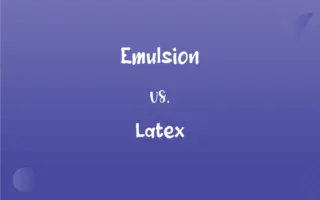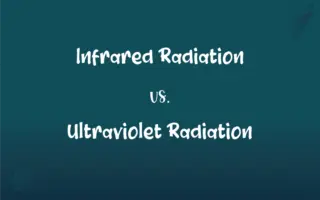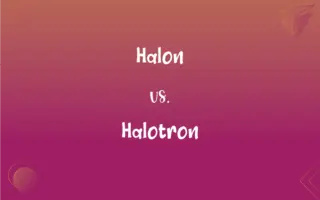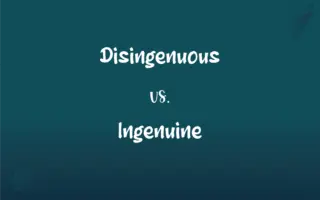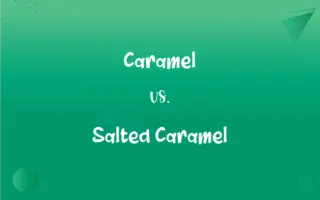Partial Pressure vs. Vapor Pressure: What's the Difference?
Edited by Aimie Carlson || By Janet White || Updated on October 17, 2023
Partial Pressure refers to the pressure exerted by a particular gas in a mixture, whereas Vapor Pressure is the pressure exerted by a vapor in equilibrium with its liquid phase.
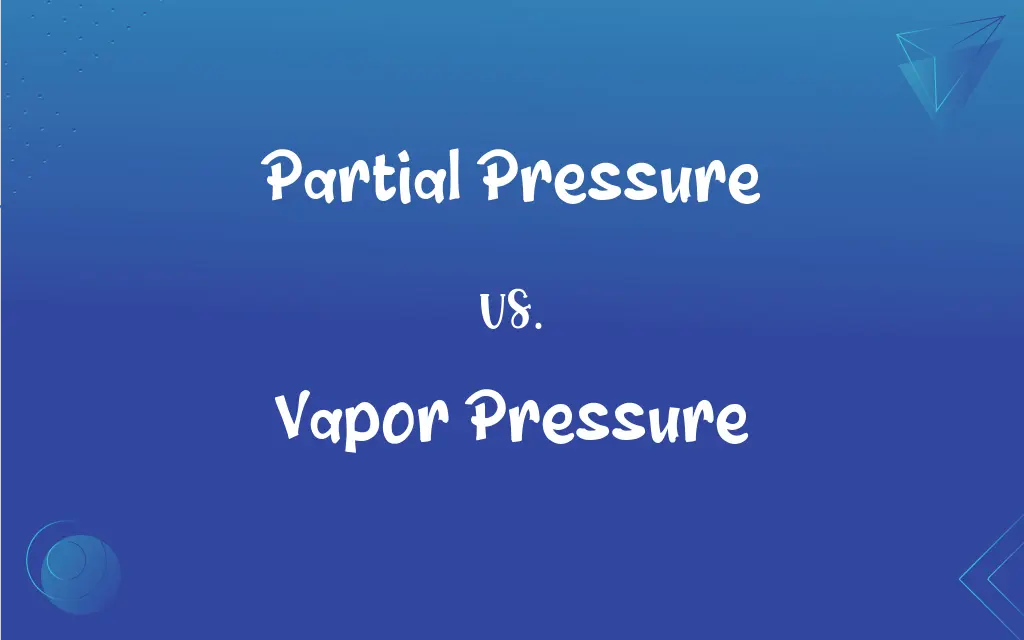
Key Differences
Partial Pressure is the pressure of a specific gas component in a mixture of gases. Vapor Pressure, on the other hand, denotes the pressure of a vapor above its liquid in a closed system when they are in equilibrium.
While Partial Pressure can be used to describe any component of a gas mixture, Vapor Pressure specifically deals with the equilibrium pressure of vapors arising from liquids or solids.
The Partial Pressure of a gas in a mixture depends on its mole fraction and the total pressure of the mixture. Vapor Pressure, conversely, is dependent on the temperature and the inherent properties of the liquid or solid.
Dalton's law is often used to determine the Partial Pressure of gases in a mixture by multiplying the mole fraction of the gas by the total pressure. The Clausius-Clapeyron equation is commonly used to relate Vapor Pressure with temperature.
Understanding Partial Pressure is crucial in fields like respiratory physiology, where it helps in analyzing gas exchange. Vapor Pressure plays a significant role in areas like distillation and evaporation.
ADVERTISEMENT
Comparison Chart
Definition
Pressure of a specific gas in a mixture
Pressure of vapor above its liquid or solid at equilibrium
Context
Any component of a gas mixture
Equilibrium pressure of vapors from liquids or solids
Factors Affecting
Mole fraction and total pressure
Temperature and properties of the liquid or solid
Common Calculation
Dalton's law
Clausius-Clapeyron equation
Application Areas
Respiratory physiology, gas mixtures
Distillation, evaporation, phase transitions
ADVERTISEMENT
Partial Pressure and Vapor Pressure Definitions
Partial Pressure
A concept derived from Dalton's law.
Using Dalton's law, the Partial Pressure of nitrogen in the atmosphere can be calculated.
Vapor Pressure
A concept crucial in phase transitions.
At its boiling point, a liquid's Vapor Pressure equals the external pressure.
Partial Pressure
Relates to how gases contribute to total pressure.
In a mixture, each gas's Partial Pressure sums up to the mixture's total pressure.
Vapor Pressure
Determines the tendency of a substance to evaporate.
A high Vapor Pressure indicates a substance will readily evaporate.
Partial Pressure
A measure of the concentration of individual gases.
The Partial Pressure of carbon dioxide in blood indicates respiratory efficiency.
Vapor Pressure
Relates to how volatile a substance is.
Gasoline, with a high Vapor Pressure, is quite volatile.
Partial Pressure
The pressure exerted by a specific component in a gas mixture.
In our atmosphere, the Partial Pressure of oxygen is about 21% of the total atmospheric pressure.
Vapor Pressure
The pressure exerted by a vapor in equilibrium with its condensed phase.
Water has a Vapor Pressure that increases with temperature.
Partial Pressure
The individual pressure of a gas if it occupied the whole volume.
If helium alone filled a balloon, its Partial Pressure would equal the balloon's total pressure.
Vapor Pressure
An intrinsic property of a substance at a specific temperature.
The Vapor Pressure of ethanol is higher than that of water at the same temperature.
FAQs
Does increasing the concentration of a gas raise its Partial Pressure?
Yes, a higher concentration means a higher Partial Pressure for that gas.
How does temperature affect Vapor Pressure?
As temperature increases, Vapor Pressure typically rises.
Can Vapor Pressure exceed atmospheric pressure?
Yes, when a liquid's Vapor Pressure equals atmospheric pressure, it boils.
Is Vapor Pressure only seen in closed systems?
For Vapor Pressure to be in equilibrium with its liquid phase, a closed system is essential.
Is Partial Pressure only applicable to gas mixtures?
Primarily, yes. It refers to individual gases in a mixture.
How does altitude affect the Partial Pressure of oxygen?
At higher altitudes, the Partial Pressure of oxygen is lower, making breathing difficult.
Why do volatile liquids have high Vapor Pressure?
Volatile liquids easily evaporate, resulting in a high Vapor Pressure.
How is Partial Pressure used in scuba diving?
It helps determine the breathing gas mix at different depths.
Does every gas in a mixture have a Partial Pressure?
Yes, each component has its own Partial Pressure.
What is the significance of Partial Pressure in breathing?
Partial Pressure determines the amount of oxygen and carbon dioxide exchanged in the lungs.
How does a gas mask filter work concerning Partial Pressure?
Gas masks use the principle of differing Partial Pressure to remove harmful gases.
Do all liquids at the same temperature have the same Vapor Pressure?
No, Vapor Pressure is specific to each liquid and varies with temperature.
Is Vapor Pressure dependent on the amount of liquid?
No, Vapor Pressure is an intrinsic property and depends only on temperature.
How do gas laws relate to Partial Pressure?
Dalton's law, in particular, describes the relationship between gases in a mixture and their Partial Pressure.
What happens to Vapor Pressure at the critical point of a substance?
At the critical point, Vapor Pressure is undefined as liquid and gas phases merge.
Can Partial Pressure be negative?
No, pressures, including Partial Pressure, cannot be negative.
Can solids have Vapor Pressure?
Yes, solids can sublimate and have an associated Vapor Pressure.
Why does a liquid with high Vapor Pressure evaporate quickly?
High Vapor Pressure indicates stronger tendencies for molecules to escape the liquid phase.
In a sealed container, can the Partial Pressure of a gas change?
If the temperature and quantity of gas remain constant, its Partial Pressure won't change.
Why do liquids boil faster at higher altitudes concerning Vapor Pressure?
At higher altitudes, atmospheric pressure is lower, so the Vapor Pressure of a liquid equals it at a lower temperature.
About Author
Written by
Janet WhiteJanet White has been an esteemed writer and blogger for Difference Wiki. Holding a Master's degree in Science and Medical Journalism from the prestigious Boston University, she has consistently demonstrated her expertise and passion for her field. When she's not immersed in her work, Janet relishes her time exercising, delving into a good book, and cherishing moments with friends and family.
Edited by
Aimie CarlsonAimie Carlson, holding a master's degree in English literature, is a fervent English language enthusiast. She lends her writing talents to Difference Wiki, a prominent website that specializes in comparisons, offering readers insightful analyses that both captivate and inform.
